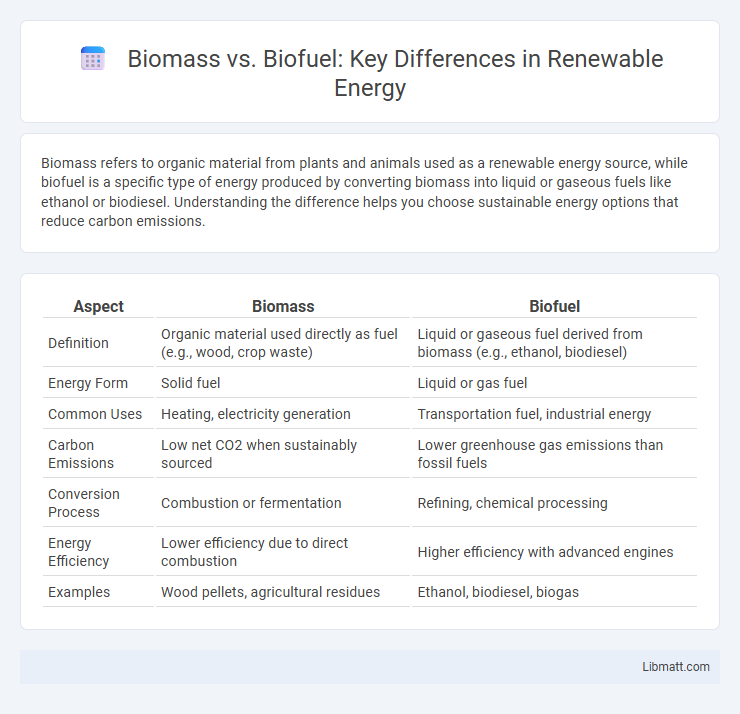Biomass refers to organic material from plants and animals used as a renewable energy source, while biofuel is a specific type of energy produced by converting biomass into liquid or gaseous fuels like ethanol or biodiesel. Understanding the difference helps you choose sustainable energy options that reduce carbon emissions.
Table of Comparison
| Aspect | Biomass | Biofuel |
|---|---|---|
| Definition | Organic material used directly as fuel (e.g., wood, crop waste) | Liquid or gaseous fuel derived from biomass (e.g., ethanol, biodiesel) |
| Energy Form | Solid fuel | Liquid or gas fuel |
| Common Uses | Heating, electricity generation | Transportation fuel, industrial energy |
| Carbon Emissions | Low net CO2 when sustainably sourced | Lower greenhouse gas emissions than fossil fuels |
| Conversion Process | Combustion or fermentation | Refining, chemical processing |
| Energy Efficiency | Lower efficiency due to direct combustion | Higher efficiency with advanced engines |
| Examples | Wood pellets, agricultural residues | Ethanol, biodiesel, biogas |
Introduction to Biomass and Biofuel
Biomass refers to organic material derived from plants, animals, and microorganisms that can be used as a renewable energy source. Biofuel is a type of fuel produced through the conversion of biomass into liquid or gaseous forms such as ethanol, biodiesel, or biogas, which serve as alternatives to fossil fuels. Understanding the distinction between biomass as a raw resource and biofuel as a processed energy product is essential for optimizing your renewable energy choices.
Definitions: What is Biomass?
Biomass refers to organic materials derived from plants, animals, and microorganisms that can be used as a renewable energy source. It includes wood, agricultural residues, and organic waste, which store chemical energy from sunlight through photosynthesis. Your understanding of biomass is essential for exploring its conversion into biofuels, which are liquid or gaseous energy carriers produced by refining biomass.
Definitions: What are Biofuels?
Biofuels are renewable energy sources derived from organic materials such as plant biomass, animal fats, or waste, designed to replace conventional fossil fuels in transportation and heating. Unlike raw biomass, which includes all biological material, biofuels undergo processing to convert them into liquid or gaseous fuels like ethanol, biodiesel, or biogas. Your choice between biomass and biofuel depends on the desired energy application and conversion technology.
Types of Biomass Materials
Biomass materials include wood, agricultural residues, animal manure, and organic waste, each serving as a primary source for biofuel production. Biofuels like ethanol and biodiesel are derived through processes that convert these diverse biomass types into usable energy. Understanding the specific characteristics of your biomass feedstock can optimize biofuel yield and sustainability.
Types of Biofuels
Biofuels primarily include ethanol, biodiesel, and biogas, each derived from different biomass sources such as corn, sugarcane, vegetable oils, and organic waste. Ethanol, a common biofuel, is typically produced through the fermentation of carbohydrates found in crops like corn and sugarcane, while biodiesel is manufactured from vegetable oils or animal fats through transesterification. Biogas, generated from the anaerobic digestion of organic materials like manure and food waste, offers a renewable energy source suitable for electricity generation and heating.
Production Processes: Biomass vs Biofuel
Biomass production involves the direct collection or cultivation of organic materials such as wood, agricultural residues, and animal waste, which serve as raw feedstock. Biofuel production converts these biomass materials through processes like fermentation, transesterification, and gasification to produce liquid or gaseous fuels such as ethanol, biodiesel, and biogas. Understanding your choice between biomass and biofuel depends on whether you need raw energy sources or refined fuels suitable for transportation and industrial applications.
Environmental Impact and Sustainability
Biomass and biofuel differ significantly in environmental impact and sustainability, with biomass serving as a raw organic material source, and biofuel representing processed energy products derived from biomass. Your choice between biomass and biofuel will influence carbon emissions, with biofuels often offering cleaner combustion and reduced greenhouse gases compared to raw biomass burning. Sustainable practices in sourcing biomass, such as using waste materials or dedicated energy crops, are critical to minimizing deforestation and conserving biodiversity while supporting renewable energy goals.
Energy Efficiency Comparison
Biomass energy conversion generally shows lower efficiency rates, typically ranging from 20% to 25%, due to the direct combustion process used to generate heat or electricity. Biofuels like ethanol and biodiesel offer higher energy efficiency, often between 30% and 40%, by converting biomass into liquid fuels that produce more energy per unit volume during combustion. The overall energy return on investment (EROI) for biofuels tends to surpass biomass combustion, making biofuels a more efficient option for transportation and power generation.
Applications and End Uses
Biomass is primarily used as a direct source of energy for heating, electricity generation, and as raw material in industrial processes, while biofuel is refined into liquid fuels such as ethanol and biodiesel for transportation. Biomass applications include power plants, residential heating, and bio-based product manufacturing. Biofuel end uses target internal combustion engines in vehicles, providing a renewable alternative to fossil fuels in automotive and aviation sectors.
Future Trends in Biomass and Biofuel
Innovations in biomass conversion technologies, such as advanced thermal and enzymatic processes, are driving higher efficiency and yield in biofuel production. Growing investment in second- and third-generation biofuels derived from non-food biomass sources, like algae and agricultural residues, is expected to reduce competition with food crops and lower carbon emissions. Integration of biomass energy systems with carbon capture and storage (CCS) aims to achieve negative emissions, positioning biofuels as a critical component of future sustainable energy strategies.
Biomass vs Biofuel Infographic

 libmatt.com
libmatt.com